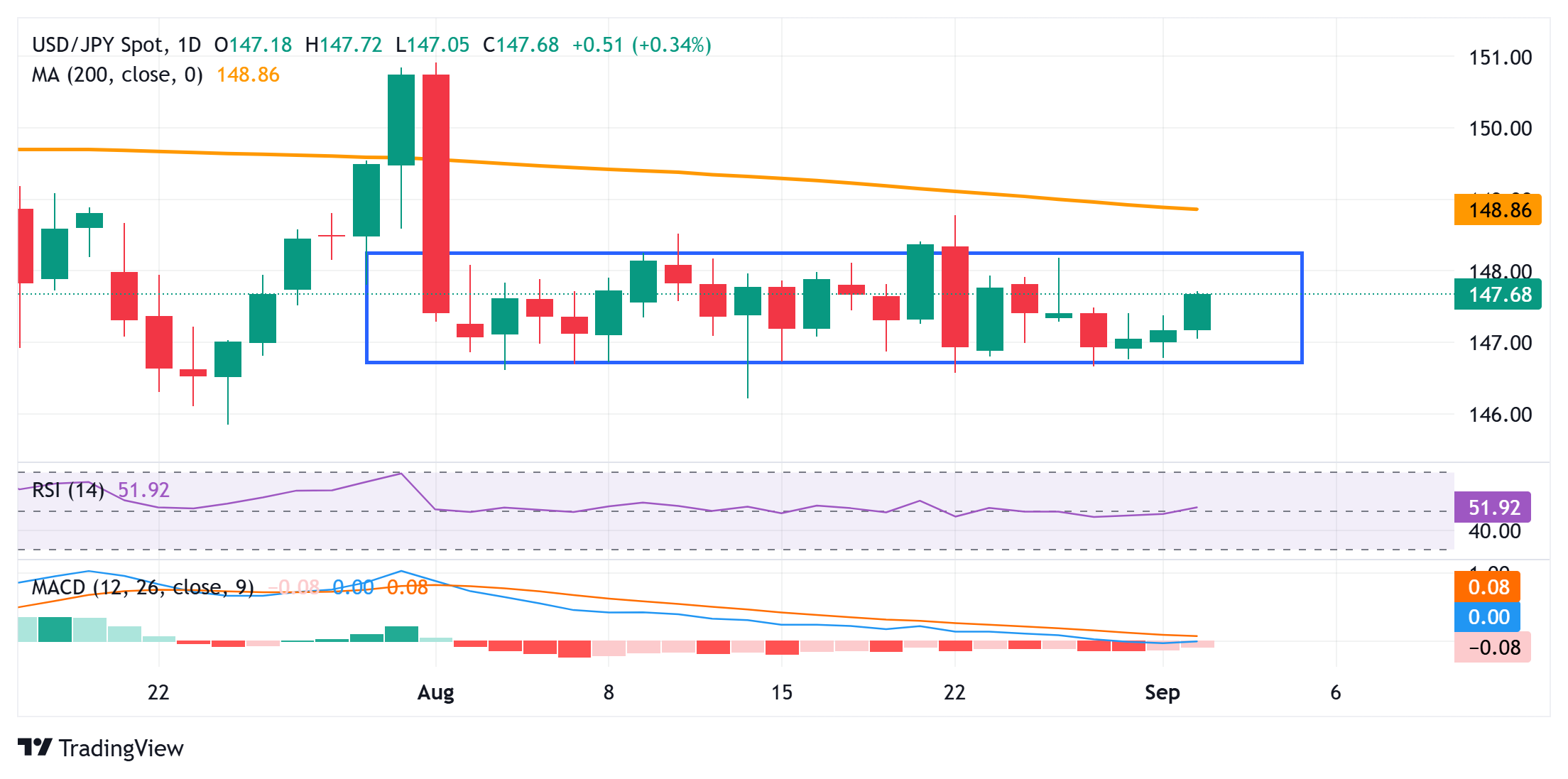Created
: 2025.09.02














![]() 2025.09.02 11:35
2025.09.02 11:35
The Japanese Yen (JPY) trades with a negative bias for the third consecutive day against a rebounding US Dollar (USD), lifting the USD/JPY pair to a nearly one-week high, around the 147.65 area during the Asian session on Tuesday. The uncertainty over the likely timing of the next interest rate hike by the Bank of Japan (BoJ) is seen as a key factor undermining the JPY. That said, investors seem convinced that the BoJ will stick to its policy normalization path, which in turn warrants some caution before positioning for any further JPY depreciation.
Apart from this, the cautious market mood and escalating geopolitical tensions might contribute to limiting losses for the safe-haven JPY. The USD, on the other hand, might struggle to attract any meaningful buyers amid bets that the Federal Reserve (Fed) will lower borrowing costs in September and deliver at least two rate cuts by the year-end. The outlook marks a significant divergence in comparison to hawkish BoJ expectations and should help limit deeper losses for the lower-yielding JPY, which, in turn, might keep a lid on the USD/JPY pair.

From a technical perspective, the USD/JPY pair's move up over the past three days validates a support marked by the lower boundary of a four-week-old trading range, around the 146.70 region. The said area should act as a key pivotal point, which, if broken decisively, could drag spot prices to the August swing low, around the 146.20 area, en route to the 146.00 mark. Some follow-through selling will be seen as a fresh trigger for bearish traders and pave the way for deeper losses.
On the flip side, any further move up could attract fresh sellers and remain capped ahead of the 148.00 round figure, which represents the top end of the multi-week-old trading band. A sustained strength beyond could prompt a short-covering rally towards the recent swing high, around the 148.75-148.80 region. The latter nears the 200-day Simple Moving Average (SMA). Hence, some follow-through buying might shift the near-term bias in favor of the USD/JPY bulls.
The Bank of Japan (BoJ) is the Japanese central bank, which sets monetary policy in the country. Its mandate is to issue banknotes and carry out currency and monetary control to ensure price stability, which means an inflation target of around 2%.
The Bank of Japan embarked in an ultra-loose monetary policy in 2013 in order to stimulate the economy and fuel inflation amid a low-inflationary environment. The bank's policy is based on Quantitative and Qualitative Easing (QQE), or printing notes to buy assets such as government or corporate bonds to provide liquidity. In 2016, the bank doubled down on its strategy and further loosened policy by first introducing negative interest rates and then directly controlling the yield of its 10-year government bonds. In March 2024, the BoJ lifted interest rates, effectively retreating from the ultra-loose monetary policy stance.
The Bank's massive stimulus caused the Yen to depreciate against its main currency peers. This process exacerbated in 2022 and 2023 due to an increasing policy divergence between the Bank of Japan and other main central banks, which opted to increase interest rates sharply to fight decades-high levels of inflation. The BoJ's policy led to a widening differential with other currencies, dragging down the value of the Yen. This trend partly reversed in 2024, when the BoJ decided to abandon its ultra-loose policy stance.
A weaker Yen and the spike in global energy prices led to an increase in Japanese inflation, which exceeded the BoJ's 2% target. The prospect of rising salaries in the country - a key element fuelling inflation - also contributed to the move.
![]()
Created
: 2025.09.02
![]()
Last updated
: 2025.09.02

FXStreet is a forex information website, delivering market analysis and news articles 24/7.
It features a number of articles contributed by well-known analysts, in addition to the ones by its editorial team.
Founded in 2000 by Francesc Riverola, a Spanish economist, it has grown to become a world-renowned information website.
We hope you find this article useful. Any comments or suggestions will be greatly appreciated.
We are also looking for writers with extensive experience in forex and crypto to join us.
please contact us at [email protected].
Disclaimer:
All information and content provided on this website is provided for informational purposes only and is not intended to solicit any investment. Although all efforts are made in order to ensure that the information is correct, no guarantee is provided for the accuracy of any content on this website. Any decision made shall be the responsibility of the investor and Myforex does not take any responsibility whatsoever regarding the use of any information provided herein.
The content provided on this website belongs to Myforex and, where stated, the relevant licensors. All rights are reserved by Myforex and the relevant licensors, and no content of this website, whether in full or in part, shall be copied or displayed elsewhere without the explicit written permission of the relevant copyright holder. If you wish to use any part of the content provided on this website, please ensure that you contact Myforex.
Myforex uses cookies to improve the convenience and functionality of this website. This website may include cookies not only by us but also by third parties (advertisers, log analysts, etc.) for the purpose of tracking the activities of users. Cookie policy